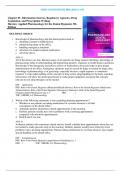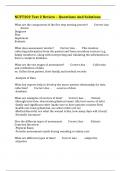MEDCONNOISSEURLIBRARIES.COM
Chapter 01: Information Sources, Regulatory Agencies, Drug
Legislation, and Prescription Writing
Haveles: Applied Pharmacology for the Dental Hygienist, 9th
Edition
MULTIPLE CHOICE
1. Knowledge of pharmacology aids the dental professional in
a. obtaining a patient’s health history.
b. administering drugs in the office.
c. handling emergency situations.
d. selection of a nonprescription medication.
e. All of the above.
ANS: E
All of the choices are true. Because many of our patients are being treated with drugs, knowledge of
pharmacology helps in understanding and interpreting patients’ responses to health history questions.
Knowledge of the therapeutic and adverse effects of medications obviously helps in their proper
administration in the office. Emergency situations may be caused by drugs or treated by drugs; thus,
knowledge of pharmacology is of great help, especially because a rapid response is sometimes
required. A clear understanding of the concepts of drug action, drug handling by the body, and drug
interactions will allow the dental practitioner to make proper judgments and grasp the concepts
relevant to new drug therapies on the market.
DIF: Application
REF: Role of the Dental Hygienist (Medication/Health History), Role of the Dental Hygienist (Medication
Administration), Role of the Dental Hygienist (Emergency Situations), Role of the Dental Hygienist
(Nonprescription Medication) | pp. 2-3 OBJ: 1
TOP: NBDHE, 6.0. Pharmacology
2. Which of the following statements is true regarding planning appointments?
a. Whether or not patients are taking medication for systemic diseases is of little
consequence in the dental office.
b. Asthmatic patients should have dental appointments in the morning.
c. Diabetic patients usually have fewer problems with a morning appointment
compared with afternoon appointments.
d. Both B and C are true.
ANS: D
Asthmatic patients who experience dental anxiety should schedule their appointments when they are
not rushed or under pressure early in the morning. Diabetic patients usually have relatively fewer
problems with a morning appointment. Patients taking medication for systemic diseases may require
special handling in the dental office.
DIF: Comprehension
REF: Role of the Dental Hygienist (Appointment Scheduling) | p. 3
OBJ: 1 TOP: NBDHE, 6.0. Pharmacology
, MEDCONNOISSEURLIBRARIES.COM
3. Nutritional or herbal supplements
a. carry the U.S. Food and Drug Administration (FDA) approval for disease states.
b. are not drugs.
c. can cause adverse effects.
d. will not interact with other drugs the patient may be taking.
ANS: C
Nutritional or herbal supplements are quite capable of causing adverse effects. The majority of
nutritional or herbal supplements do not carry FDA approval for treating disease states. These
supplements are drugs and can cause adverse effects and interact with different drugs.
DIF: Comprehension
REF: Role of the Dental Hygienist (Nutritional or Herbal Supplements) | p. 3
OBJ: 1 TOP: NBDHE, 6.0. Pharmacology
4. Which type of drug name usually begins with a lowercase letter?
a. Brand name
b. Code name
c. Generic name
d. Trade name
ANS: C
Before any drug is marketed, it is given a generic name that becomes the “official” name of the drug.
Each drug is assigned only one generic name selected by the U.S. Adopted Name Council, and the
name is not capitalized. The brand name is equivalent to the trade name and is capitalized. Although
the brand name is technically the name of the company marketing the product, this term is often used
interchangeably with the trade name. The code name is the initial term used within a pharmaceutical
company to refer to a drug while it is undergoing investigation and is often a combination of capital
letters and numbers, the letters representing an abbreviation of the company name.
DIF: Comprehension REF: Drug Names | p. 4
OBJ: 3 TOP: NBDHE, 6.0. Pharmacology
5. A drug’s generic name is selected by the
a. pharmaceutical company manufacturing it.
b. Food and Drug Administration (FDA).
c. U.S. Adopted Name Council.
d. Federal Patent Office.
ANS: C
Each drug is assigned only one generic name (e.g., ibuprofen). It is selected by the U.S. Adopted
Name Council. The generic name is not selected by the FDA or the Federal Patent Office. The
pharmaceutical company manufacturing the drug clearly has an influence on the generic name given
its drug, but the final decision is not the company’s.
DIF: Recall REF: Drug Names | p. 4 OBJ: 3
TOP: NBDHE, 6.0. Pharmacology
6. Which of the following is true concerning generic and trade names of drugs?
a. A drug may only have one generic name and one trade name.
, MEDCONNOISSEURLIBRARIES.COM
b. A drug may only have one generic name, but it may have several trade names.
c. A drug may have several generic names, but it may only have one trade name.
d. A drug may have several generic names and several trade names.
ANS: B
Each drug has only one generic name but may have several trade names. For each drug, there is only
one generic name. It is not capitalized, and it becomes the “official” name of the drug. The
pharmaceutical company discovering the drug gives the drug a trade name. The trade name is
protected by the Federal Patent Law for 20 years from the earliest claimed filing date, plus patent term
extensions. Although the brand name is technically the name of the company marketing the product, it
is often used interchangeably with the trade name.
DIF: Comprehension REF: Drug Names | p. 4
OBJ: 3 TOP: NBDHE, 6.0. Pharmacology
7. Two drugs that are found to be chemically equivalent, but not biologically equivalent or
therapeutically equivalent are said to differ in
a. potency.
b. efficacy.
c. bioavailability.
d. therapeutic index.
ANS: C
A preparation can be chemically equivalent yet not biologically or therapeutically equivalent. These
products are said to differ in their bioavailability. The potency of a drug is a function of the amount of
drug required to produce an effect. The efficacy is the maximum intensity of effect or response that
can be produced by a drug. The therapeutic index is the ratio of the lethal dose for 50% of the
experimental animals divided by the effective dose for 50% of the experimental animals. If the value
of the therapeutic index is small, toxicity is more likely.
DIF: Recall REF: Drug Names (Drug Substitution) | p. 5
OBJ: 4 TOP: NBDHE, 6.0. Pharmacology
8. How many years must pass after a drug patent expires before other drug companies can market the
same compound as a generic drug?
a. 20 years
b. 17 years
c. 7 years
d. 0 years
ANS: D
Once a drug patent expires, competing companies may immediately market the same compound in
generic form. The pharmaceutical company discovering the drug gives the drug a trade name. The
trade name is protected by the Federal Patent Law for 20 years from the earliest claimed filing date,
plus the patent term extensions.
DIF: Application REF: Drug Names (Drug Substitution) | p. 5
OBJ: 4 TOP: NBDHE, 6.0. Pharmacology
, MEDCONNOISSEURLIBRARIES.COM
9. Two drug formulations that produce similar concentrations in the blood and tissues after drug
administration are termed equivalent.
a. chemically
b. biologically
c. therapeutically
ANS: B
Biologic equivalence refers to identical pharmacokinetic parameters of two drug formulations
(bioequivalence, for short). Chemical equivalence indicates that two formulations of a drug meet the
chemical and physical standards established by the regulatory agencies. Therapeutic equivalence
means that two formulations produce the same therapeutic effects over the same duration.
DIF: Application REF: Drug Names (Drug Substitution) | p. 5
OBJ: 4 TOP: NBDHE, 6.0. Pharmacology
10. The federal body that determines whether a drug is considered a controlled substance and to which
schedule it belongs is the
a. Food and Drug Administration (FDA).
b. Federal Trade Commission (FTC).
c. Drug Enforcement Administration (DEA).
d. U.S. Pharmacopeia (USP).
ANS: C
The DEA regulates the manufacture and distribution of substances with abuse potential. Hence
prescriber DEA numbers must appear on prescriptions for controlled substances. The FDA does not
have any special powers in regard to drugs of abuse. The FTC regulates commerce and advertising
claims of foods, over-the-counter (OTC) products, and cosmetics. The USP regulates the uniformity
and purity of drugs.
DIF: Comprehension
REF: Federal Regulations and Regulatory Agencies (US Drug Enforcement Administration) | p. 5
OBJ: 5 TOP: NBDHE, 6.0. Pharmacology
11. Which federal regulatory agency decides which drugs require a prescription and which drugs may be
sold over-the-counter (OTC)?
a. FDA
b. OSHA
c. FTC
d. DEA
ANS: A
The Food and Drug Administration (FDA) is part of Department of Human and Health Services
(DHHS), and determines what drugs may be sold by prescription and OTC and regulates the labeling
and advertising of prescription drugs. The Occupational Safety and Health Administration (OSHA)
ensures the safety and health of workers in the United States by setting and enforcing standards. The
Federal Trade Commission (FTC) regulates the trade practices of drug companies and prohibits the
false advertising of foods, nonprescription (OTC) drugs, and cosmetics. The Drug Enforcement
Administration (DEA) is a part of the Department of Justice and regulates the manufacture and
distribution of substances that have a potential for abuse, including opioids, stimulants, and sedatives.






